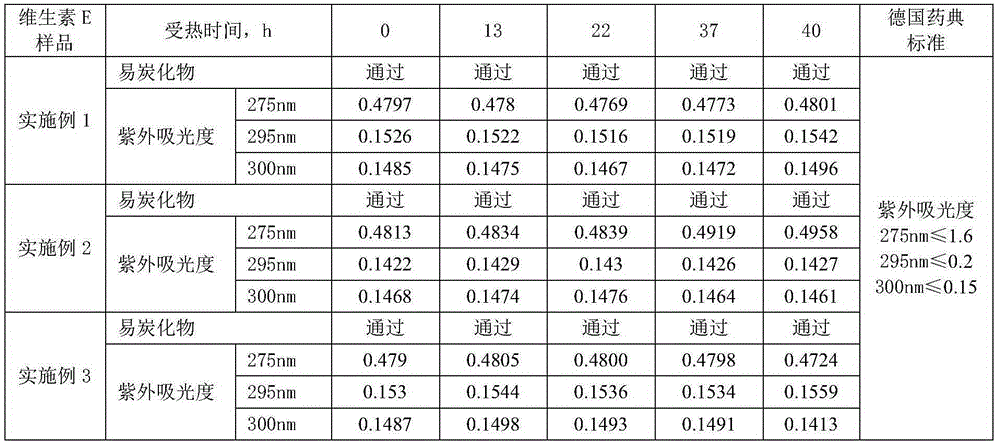Anti-oxidation composition and application thereof
A technology of antioxidant and composition, applied in the field of application of antioxidant composition in food-grade white oil, which can solve problems such as increased UV absorbance, yellowing of color, complex chemical reactions, etc.
- Summary
- Abstract
- Description
- Claims
- Application Information
AI Technical Summary
Problems solved by technology
Method used
Image
Examples
example 1-3
[0037] Examples 1-3 are the specific composition of the antioxidant composition product of the present invention, comparative example 1 is an α-tocopherol antioxidant, comparative example 2 is a natural vitamin E mixed tocopherol antioxidant, and comparative example 3 is an antioxidant composition without adding blank food grade white oil. Based on the total weight of the antioxidant composition, each component is added in proportion to a mixing container, stirred at normal temperature and pressure for 2 hours, and a uniform transparent light yellow viscous liquid is obtained, which is the product of the present invention. The results are shown in Table 1.
[0038] Table 1 Composition of antioxidant products
[0039] serial number α-tocopherol, % Natural vitamin E mixed tocopherols, % Example 1 50 50 Example 2 60 40 Example 3 70 30 Comparative example 1 100 0 Comparative example 2 0 100 Comparative example 3 0 0
Embodiment 4
[0041]In the present invention, based on the weight of the food-grade white oil, the addition amount of the antioxidant composition is 0.002% (wt%), and the test oil is No. 100 food-grade white oil. A 40h heating test was carried out at a constant temperature of 110°C. The UV absorbance (NB / SH / T 0415-2013) and easy carbonization (GB / T11079-2000) analysis of the samples during the test are shown in Table 2.
[0042] Table 2 Antioxidant Heating Evaluation Test
[0043]
[0044] The analysis in Table 2 shows that after the No. 100 food-grade white oil blank sample of Comparative Example 3 was heated for 13 hours, the analysis of easily carbonized substances failed. With the increase of heating time, the ultraviolet absorbance obviously increased and exceeded the product index requirements; After heating to 40 hours and 22 hours respectively in Example 1 and Comparative Example 2, the analysis of easily charred substances failed, and the UV absorbance increased in varying degr...
Embodiment 5
[0046] In the present invention, based on the weight of the food-grade white oil, the addition amount of the antioxidant composition is 0.01% (wt%), and the test oil is No. 100 food-grade white oil. A 40h heating test was carried out at a constant temperature of 110°C. The UV absorbance and easy carbonization analysis of samples during the test are shown in Table 3.
[0047] Table 3 Antioxidant Heating Evaluation Test
[0048]
[0049] Shown by table 3 analysis, because the addition of composite antioxidant composition is 0.01% (wt%), and addition is composite antioxidant addition range upper limit, after 110 ℃ of heating 40 hours, embodiment 1,2,3 sample Both the easily carbonized substance and the UV absorbance are qualified, showing excellent oxidation stability.
PUM
 Login to View More
Login to View More Abstract
Description
Claims
Application Information
 Login to View More
Login to View More - R&D
- Intellectual Property
- Life Sciences
- Materials
- Tech Scout
- Unparalleled Data Quality
- Higher Quality Content
- 60% Fewer Hallucinations
Browse by: Latest US Patents, China's latest patents, Technical Efficacy Thesaurus, Application Domain, Technology Topic, Popular Technical Reports.
© 2025 PatSnap. All rights reserved.Legal|Privacy policy|Modern Slavery Act Transparency Statement|Sitemap|About US| Contact US: help@patsnap.com



